 |
||
|
||
| ||
In our recent shootout of budget coolers for LGA775 we complained about the poor choice of products, few model lines, and shortage of such products on our market. Unfortunately, a similar situation can now be seen in the budget sector of Socket 754/939 coolers as well — feeling nostalgic about the bygone abundance of low and middle end models, adapted for AMD processors (the market used to be choking with the surplus of various coolers), we have to establish a fact: the deficit here is not less severe than in case with the LGA775 platform. The reasons for these two phenomena are similar — the modern market condition dictates quite different terms, which changed cardinally for the last years. Many cooler manufacturers are in no haste to invest into low-profit budget production, they obviously give in to the increasing reign of boxed AMD processors (they come shipped with good coolers), preferring to actively develop much more profitable high-end products. As a result, high-end coolers are becoming sort of a mainstream — the main engine in the cooling sector (the fact that the heat envelope of even the top processors still agrees well with capacities of budget coolers is naturally ignored). In the near future the market of budget models may collapse — meaning no significant alternatives to boxed coolers. Let's hope our pessimistic assumptions will not come true. And now let's put aside thankless forecasts and advert to the present day affairs. We are going to test another group of 8 budget products for the Socket 754/939 platform, which includes two CK8-JD2B series models from Cooler Master, four Igloo 7300 series models from GlacialTech, as well as Speeze DolphinReef III and TR2 M14 SE coolers. So, let's proceed! Cooler Master CK8-JD2B-0L and CK8-JD2B-01Our list starts with two budget models from Cooler Master — CK8-JD2B-0L and CK8-JD2B-01. These coolers are based on the same aluminum 77x79x42 mm finned heatsink, equipped with a 80x80x25 mm fan and a toolless mounting system. 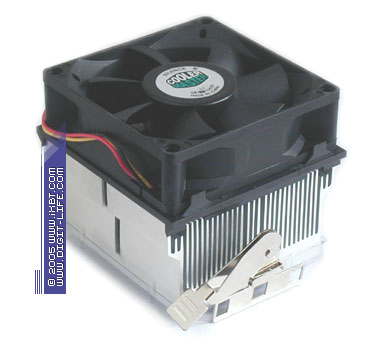 Cooler Master CK8-JD2B-0L CK8-JD2B heatsink demonstrates a good finning configuration (0.8 mm thick fins at 1 mm steps with the total heat exchange surface area of about 1450 cm2). Besides, it's additionally spiced up with an impressive technical benefactor — a large 44x11 mm copper disc, pressed at the base. The disc is molded accurately and with proper quality. It's a weighty reason to expect more efficient redistribution of the heat flow across the working medium of the heatsink with proper optimization of the contact thermal resistance in the processor-cooler pair. 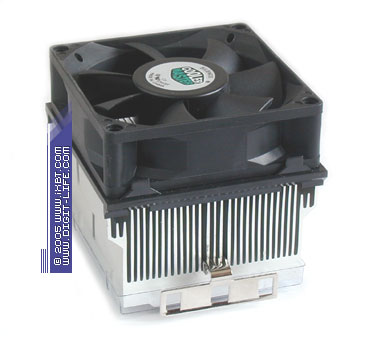
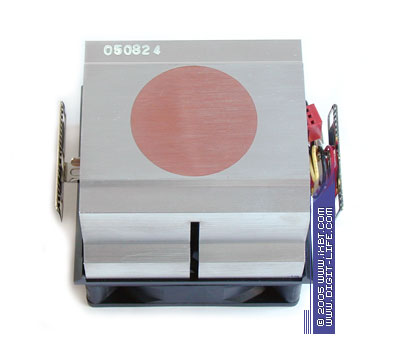 Operating properties of the CK8-JD2B-0L and CK8-JD2B-01 models also look worthy: the coolers offer a simple but well thought-out and installation-friendly mounting system (a combination of a standard 6-pin clip and a lever), which fixes a heatsink in a socket. Preinstalled thermal interface is an evident advantage here as well — highly efficient thermal paste (filling agent is a composition of aluminum oxide and nitride) possessing improved thermophysical properties. 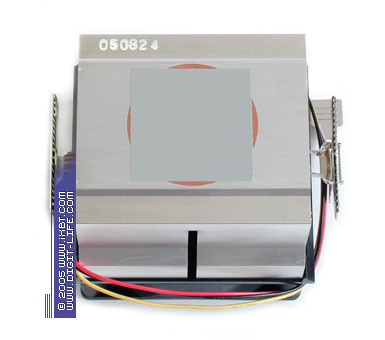 CK8-JD2B series coolers efficiently cope with their tasks thanks to the good design. The best results are demonstrated by the CK8-JD2B-0L model (2500 rpm) — this cooler shakes off its boxed colleagues — Ajigo MF043-044 and MF064-074. It gets closer to the temperature readings of much more advanced competitors, close on the heels of the previous champion — Zalman CNPS7000B-Cu, and presses for its hypertrophied tribesman — huge Hyper 6 with heat pipes. The noise level is kept strictly within decent bounds: even if the CK8-JD2B-0L is not truly a low-noise model, its noise does not cross the ergonomics boundary. The other model — CK8-JD2B-01, equipped with a faster fan (3000 rpm), confidently copes with a heated processor as well. It demonstrates better thermal efficiency. But on the whole, it's still worse than its slow brother CK8-JD2B-0L, as it demonstrates less friendly noise characteristics. GlacialTech Igloo 7300 Light, Igloo 7300, Igloo 7300 Pro, and Igloo 7300 TCThe next models in our list are from an updated budget series from GlacialTech — Igloo 7300, including Igloo 7300 Light, Igloo 7300, Igloo 7300 Pro, and Igloo 7300 TC. These coolers are based on an aluminum 88x87x45 mm heatsink with a 90x90x25 mm fan. They traditionally rank by their nominal rpms (1900, 2400, 3000 rpm). The TC-suffixed model is additionally equipped with the rpm control circuit depending on the CPU temperature (rotational speed of the fan varies from 1500 to 3000 rpm within 25-40°C).  GlacialTech Igloo 7300 Light and Igloo 7300 Pro In technical terms, new Igloo 7300 models are direct descendants from the Igloo 7200 series — the updated image is mostly based on the design adapted for a larger fan, so the changes and improvements are quantitative rather than ideological here.  GlacialTech Igloo 7200 Pro and Igloo 7300 Pro Igloo 7300 heatsink is again improved with Igloo's typical catalysts of heat efficiency — tapered section fins and fin height alternation (this symbiosis enhances thermal and hydraulic efficiency of the finning). It also inherited from Igloo 7200 a special base profile with wave-like bulges, which contribute to the reduction of contact thermal resistance between the CPU and cooler, but with higher technological finning parameters (0.5 mm thick at the base and 0.2 mm at the tip) and a more developed heat exchange surface (1800 cm2 versus 1500 cm2 in Igloo 7200). But due to the improved fin profile, the new coolers have grown just by 60 g in weight (430 g versus 370 g in Igloo 7200), keeping within the AMD requirements.  New budget Igloo 7300 models possess practically the same ergonomics features of the Igloo 7200 series — their retention system suffered no significant changes, they are just as easily installed into a socket. Preinstalled thermal interface is also left where it should be — highly efficient thermal paste (filling agent is a composition of aluminum oxide and nitride) possessing improved thermophysical properties.  We have encountered changes in thermal and noise characteristics, quite positive at that. Igloo 7300 Light demonstrates really grandiose results (if we can say so about a budget cooler) — it manages to outperform Igloo 7200 Light by 5°C, keeping to the low-noise ergonomics! Igloo 7300 Light fairs well not only among its "tribesmen", but also among the other contenders — this cooler confidently outperforms boxed models and gets close to the results of advanced models from Zalman (operating in Silent Mode). Igloo 7300 Pro and Igloo 7300 demonstrate no less interesting functionality. Their thermal efficiency is practically on a par with Cooler Master budget coolers from the CK8-JD2B series (being outperformed in the efficiency-noise ratio) and seriously compete with many coolers of a higher class. What concerns Igloo 7300 TC with thermal control, results of this cooler in typical conditions (environment temperature inside a PC case: 30°C) are practically on the level with Igloo 7300. Speeze DolphinReef IIINow it's turn of a Speeze representative for Socket 754/939 — DolphinReef 3. This cooler is based on an aluminum 77x68x40 mm heatsink, equipped with an "inverted" 80x80x25 mm fan with the rotational speed of 2500 rpm. It comes shipped with additional mounting devices — a retention bracket for Socket 754/939 and a standard supporting plate. 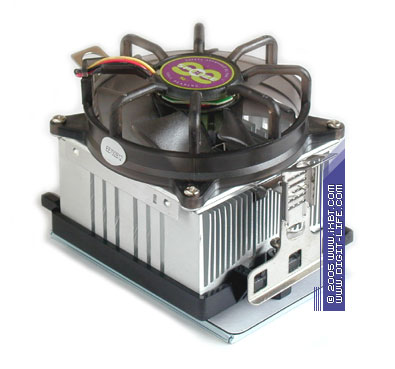 DolphinReef 3 looks plain in exterior — small dimensions and weak finning are actually not impressive. But the internals are actually quite decent at a closer inspection — DolphinReef 3 offers good fin parameters (tapered section fins, 0.8 mm thick at the base and 0.3 mm thick at the tip), plus an additional thermal benefactor — a copper disc (35 mm in diameter) pressed into the base. Though the total area of the heat exchange surface in this heatsink is just about 1000 cm 2, the efficient finning configuration and an easily blown-though finning profile are good advantages. 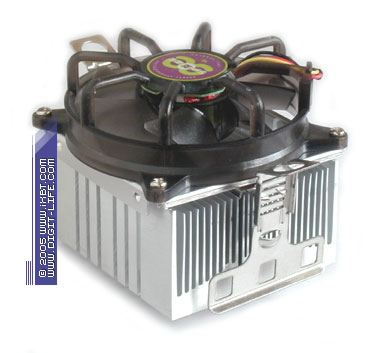
 Fortunately, DolphinReef 3 takes advantage of these features and demonstrates well-balanced functionality: of course, it's far from champion results, but it competes well with the other budget coolers and demonstrates ergonomic noise characteristics with a worthy efficiency-noise ratio. Operational properties of this cooler are not bad either — although the retention mechanism of the DolphinReef 3 is less convenient than those from Cooler Master and GlacialTech, it's still easy to install the heatsink into a socket. We can just complain about the lack of preinstalled thermal interface. Besides, mounting accessories also produce an ambiguous impression — they do not come for free, thus being more of a luxury than of a necessity in a budget cooler. Thermaltake TR2 M14 SEA new model from TR2 (Thermaltake's trademark) brings up the rear in our shootout — M14 SE, which stands out against the budget level with its interesting technical design. The cooler is based on a combined copper-aluminum 75x90x38 mm heatsink with a 80x80x25 mm fan (2300 rpm) and spiced up with a toolless mounting system. 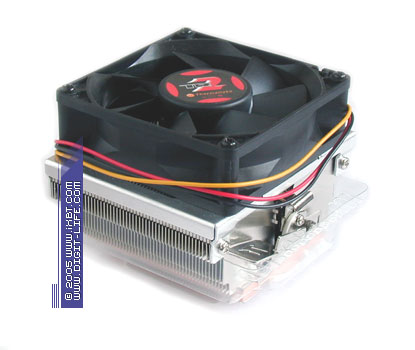
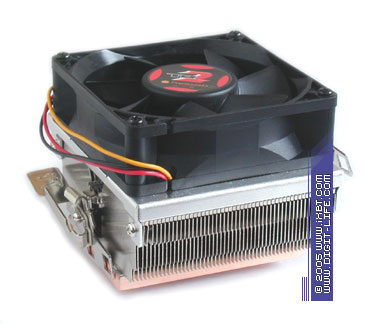 The main feature of the TR2 M14 SE is its advanced heatsink (bonded-fin) made up of 50 aluminum fins (0.3 mm thick fins at 1 mm steps) on a massive copper 75x54x6 mm base. Fins are fused thoroughly with the base — honest soldering. Together with the developed heat exchange surface (total area of about 2300 cm2), it bestows very good thermal characteristics.  The TR2 M14 SE looks no less decent in usage — the mounting system of the cooler is ideologically similar to the ergonomic retention mechanism of Cooler Master CK8-JD2B and provides for practically the same easy installation of the heatsink into a socket. Observing the same decencies, this cooler possesses the preinstalled thermal interface - standard silicone thermal paste of a good quality.  The TR2 M14 SE also copes well with its direct responsibilities — it demonstrates worthy thermal efficiency together with ergonomic noise level, successfully competing not only with budget colleagues, but also with higher-classed products. But it still does not manage to realize its full thermal potential — the low-power fan does not allow to use the tight finning of the TR2 M14 SE to the full. Well, that seems to be the end of our today's shootout of budget coolers for Socket 754/939 from Cooler Master, GlacialTech, Speeze, and Thermaltake. It's time to draw a bottom line! But before that, let's have a look at the test results. Test resultsIn order to examine thermal efficiency of our Socket 754/939 coolers, we put the same methods into service as in testing cooling systems for Socket 478 and LGA775. The primary data used for the consequent calculation of thermal resistance are temperature readings of the thermal diode built into a processor, only the thermal source is different (now it's Athlon 64 3700+ processor), the base platform (Fujitsu-Siemens D1607 motherboard), and a set of test applications. The testbed has the following configuration:
We use the S&M utility to simulate maximum thermal load of a processor, and SystemGuard from Fujitsu-Siemens to monitor temperatures. Diagram 1. Temperature readings Notes Diagram 2. Thermal resistance Note Finally, at the end of this article we publish the noise measurement results (the method of testing is described in the article Noise characteristics of coolers and the noise measurement method) as well as the efficiency/noise rating of coolers. Diagram 3. Noise characteristics
Diagram 4. Efficiency/noise ratio Note There seems to be no need in any comments here. Let's draw the bottom line! ConclusionsThe budget coolers for Socket 754/939, we reviewed today, aced our tests — they compete well with boxed models and can even seriously compete with products of a higher class (including champions of the last seasons). It's hard to determine a definite leader among them, but CK8-JD2B series coolers from Cooler Master and Igloo 7300 series coolers from GlacialTech seem the most interesting models in terms of overall functionality — these coolers possess a well-balanced set of technical properties and can provide an acceptable thermal mode even for top AMD processors, including dual-core models with the heat envelope up to 110-120 Watts. What concerns Speeze DolphinReef III and Thermaltake TR2 M14 SE, if we close our eyes to some drawbacks, they can be recommended for low and middle end AMD processors, which heat envelope is about 80-90 Watts.
Write a comment below. No registration needed!
|
Platform · Video · Multimedia · Mobile · Other || About us & Privacy policy · Twitter · Facebook Copyright © Byrds Research & Publishing, Ltd., 1997–2011. All rights reserved. |